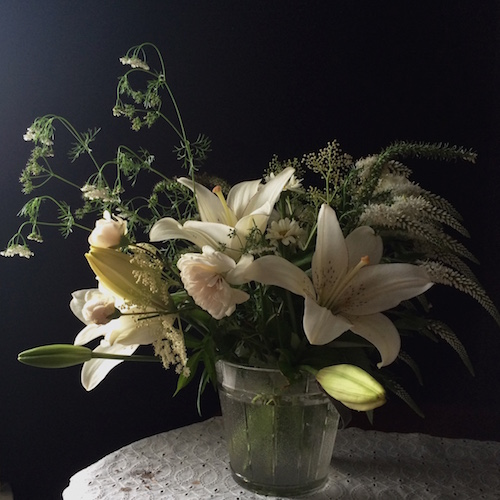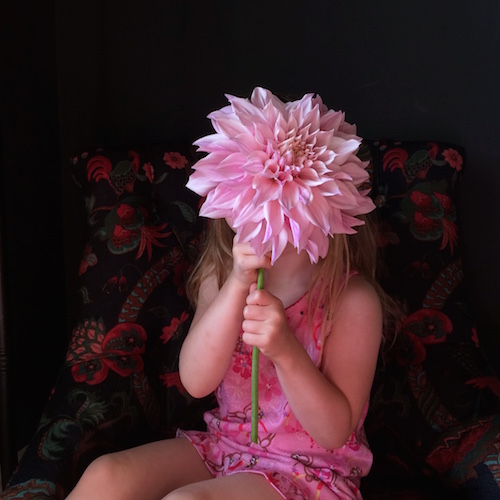
Mary, Mary, quite contrary
How does your garden grow?
1.
My flower garden grows with muck, which is a polite name for a great stinking pile only a few months removed from the back end of a horse. The garden was born when my husband and I laid overlapping layers of cardboard in an enormous square, about forty feet by forty feet. Then, wearing rubber boots and wielding rusty shovels, we spread that muck in a thick blanket over the cardboard. This was December, and the muck belched steam beneath a clear, blue sky.
New beginnings can be like that. All at once, they are too big and too small, too much and not quite enough. I prayed for snow to cover the stench and the sight. I prayed we hadn’t been wrong to smother all that perfectly fine and perfectly green grass.
2.
I can’t step onto a patch of sunny, open ground without making plans for it. Soft, green grass has its merits, but, to me, sunlight will always feel a little bit wasted on a lawn. Give me tulips. Give me morning glories. Give me color and scent. Romance and change. Give me, always, a bed of cultivated dirt.
From the day we moved to this old farmhouse called Maplehurst, I kept my eye on the open lawn directly across from the front door. I never looked at the grass and weeds there without seeing them superimposed with roses and daisies. But the gap between vision and reality is enormous. There is a wasteland between the two, and while we are in it we struggle to continue seeing the dream that led us there. Our faith falters. In January, I dog-eared the pages of my plant catalogs with longing and self-doubt. The muck might turn out to be full of weed seeds. The deer might come like diners to an all-night buffet.
3.
It isn’t easy to spend money and have only flowers to show for it. It isn’t like a donation to a charity. It isn’t like a deposit in a savings account. A flower isn’t even a carrot. I cannot fill my stew pot with flowers. In February, the number on our bank statement dwindled with the purchase of each bare-root rose and lily bulb, yet I did not have even flowers to show for it. The view from the parlor window looked just the same: bleak and brown.
Dreams ask for commitment. They require that proverbial running leap. We had smothered the lawn, and there could be no going back. In a month or two, cardboard boxes labeled “fragile,” “this side up,” and “live plants,” would begin showing up on the porch near the back door. But even if the dream was one day realized, would we say it had been worthwhile?
4.
Spring arrives in the garden long before it arrives anywhere else. As soon as the last snow had melted, as soon as the muck began to thaw, we were out in it. My husband built, slowly, picket by picket, a fence. Together, we marked the paths with twine and a few well-placed stakes. I buried lily bulbs and the bare roots of roses along the edges of the still-theoretical paths. I hoped our measurements would prove themselves true. I hoped they would prove us true.
I tended seedlings in the basement. Zinnias, cosmos, alyssum, and lace flowers stretched beneath the light of a fluorescent sun. Gardening books talk of plant combinations and color palettes, but it is all so much more uncertain than paint on a canvas or words on a page. I had chosen my varieties with care, but I could not know then that the newly amended soil would be too fertile for cosmos and lace flowers (the cosmos would grow into feathery green monsters but never bloom and the lace flowers would leap and flower and quickly rot away). I could not know that the coral zinnias would turn out to be more of a garish orange. I could not know that the white zinnias would glow in the evening like moonlight and starlight and magic.
5.
We hosted an Easter egg hunt for our neighbors. Nothing yet grew in the garden except candy-filled eggs and tiny green boxwood shrubs. Paths were merely the suggestion of rain-sodden string.
“What is that?” my neighbors asked, pointing toward the great, brown square. “What are you doing?”
“Dreaming,” I did not answer them. “Hoping,” I did not say.
“That’s our new flower garden!” I explained with a hearty voice and a trembling smile.
My husband and I consoled ourselves with every gardener’s favorite words: next year. Next year, won’t this be the perfect spot for an Easter egg hunt? Next year, won’t the roses be beautiful? Next year, won’t we say how glad we are to have done this?
6.
The wild thing about next year is that it always does come. And so much more quickly than we ever dare to hope. When you tend gardens and young children, this is both a marvelous and a heartbreaking thing. We hosted another Easter egg hunt for our neighbors this spring. This year, toddlers crunched across the garden’s gravel paths scooping up eggs. The window boxes in the potting shed spilled violets in lavender and white. The green boxwoods edged beds that, while still mostly brown and mostly empty, at least looked like what they were: places where flowers would grow.
The wild thing about next year is that it gives and it takes away, but what it gives and what it takes are so often unexpected. This year, the second in our flower garden, gave perfectly formed daffodils despite our strangely warm El Nino winter. This year took the life of my younger sister’s husband in a military helicopter crash. Not long after the Easter egg hunt, we flew to Texas for his burial.
7.
In June, I deadheaded roses and gathered the first lilies with my four grieving nieces and nephews. Every day of her visit, my youngest niece helped me fill a collection of buckets with weeds. Then, she would feed the weeds, one by one, to the chickens. “These eggs will be full of vitamins!” we took turns saying to one another.
But a flower garden costs so much more than a carton of free-range eggs from the market. There is the money for bare roots and bulbs. There is the time spent pruning and weeding. There is the frustration of watching Japanese beetles devour rose buds from the inside out. One moment it is Eden, and the next a sudden rainstorm has flattened half of the trumpet lilies. When I count the costs, I begin to doubt. But when I remember my sister gathering roses, when I think of my niece pulling weeds, I say, How glad I am to have made this garden.
8.
There are quite a few smaller places within this larger place I call home. There is the squishy sofa in the small sunroom. That is a good place to sit with a book. There is the bench shaded by wild grape vines halfway down the avenue. That is a good place to hide. There is the fenced-in square of the vegetable garden. That is a good place for sneaking the first ripe cherry tomatoes, quickly, into your mouth. But this summer, the place I love most is the flower garden.
With a shed for shelter, two benches for rest, and a wild abundance of blooms, the flower garden has grown into a sanctuary. We made it with our own hands, yet it feels like a gift I did nothing to deserve. Whether I am picking weeds, or squashing beetles, or cutting a dahlia the exact size of my young daughter’s head, I keep looking for someone to acknowledge. Of course, a sanctuary is also a good place for prayer. Perhaps that is why, as I work, I do not whistle. I only whisper, thank you, thank you, thank you.

Christie Purifoy earned a PhD in English Literature at the University of Chicago before trading the classroom for a farmhouse, a garden, and a blog. She is the author of Roots and Sky: A Journey Home in Four Seasons.















